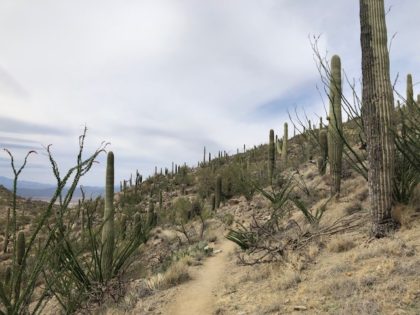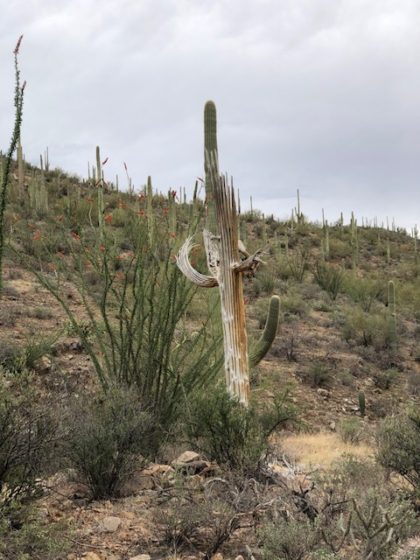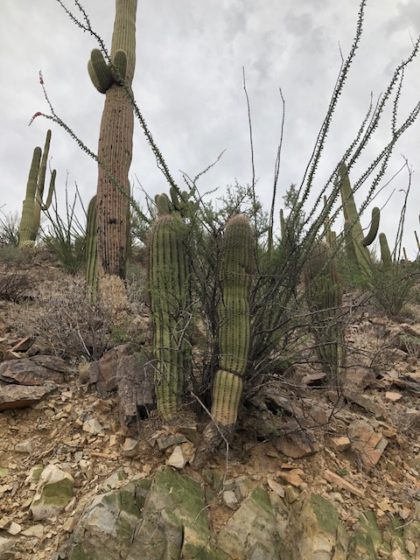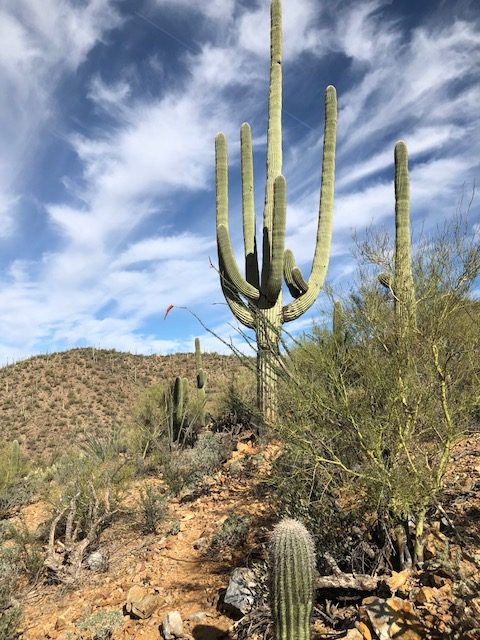Sentinels of the Desert in Saguaro National Park
There is only one place on earth where you can see a forest of Saguaro cactus – the Sonoran desert. Covering 100,000 square miles of Arizona, eastern California and northern Mexico, this is a relatively young desert – just 10,000 years old, but vibrant and complex.
Sonoran Desert
Many visualize a desert as sand, but the Sonoran desert is green and lush, with plants and animals you may find nowhere else. You will see prickly pear, ocotillo, hedgehog cactus, cholla, fishhook barrel cactus, buckhorn cholla, yucca, brittle bush, desert marigold, globe mallow, creosote, mesquite, palo verde, ironwood, jojoba, and more.
The largest and most stunning of all of these uniquely adapted plants is the Saguaro cactus, found only in the Sonoran desert and protected in the Saguaro National Park.
Saguaro National Park
There are two parts to the Saguaro National Park – one to the east and one to the west of the city of Tucson, Arizona. The eastern part is a bit more difficult to get to, but it is amazing. This is the “Rincon” district, established as a National Monument in the 30’s to protect the valley and the mountains to the southeast of Tucson, preserving habitat from the desert floor – home to javelina and cactus – up to the tallest peak of over 8,600 feet with ponderosa pine trees and bears.
Running in the Park
We came to this part of the park specifically to do a run through the saguaros. There is an 8-mile one way loop road that provides an amazing experience. When we went there, we saw more cyclists, runners and walkers on the road than we saw cars. It was so quiet out there – other than the birds and the sounds of the quail, all you could hear were your own footsteps. A perfect place to run!!!
Hint: Go early before the visitors start to drive through. Park at the visitor center. Be sure to take water. Be warned. It is hilly but worth the trek!
There is a visitor center with nature trails and the drive is well worth it. There are also miles of hiking trails on this side of the park from flat desert trails to back country back packing and camping.
Hiking in the Park
 We chose to do our hiking on the western part of the park – the Tucson Mountain district to the west of Tucson. This is the more visited of the two districts because of other attractions in the area including the Arizona-Sonora Desert Museum and also “Old Tucson” – an movie set home to many of the old western’s you will remember. Over 400 films were made here with stars including John Wayne, Clint Eastwood, and more.
We chose to do our hiking on the western part of the park – the Tucson Mountain district to the west of Tucson. This is the more visited of the two districts because of other attractions in the area including the Arizona-Sonora Desert Museum and also “Old Tucson” – an movie set home to many of the old western’s you will remember. Over 400 films were made here with stars including John Wayne, Clint Eastwood, and more.
In the western district there are lots of choices of hikes – in fact, there are over 175 miles of trails with in the National Park. We chose to hike to the top of Wasson Peak – a nice 8 mile hike with great views of the city and gorgeous scenery. It has been a pretty dry year, but there are still lots of wild flowers starting to bloom. You just have to look carefully and you will see tiny yellow, orange, blue and purple blossoms.
It was interesting to hike past the old mines – crazy that you can still see all the tailings after 80+ years. Thank goodness that in the 70’s the government designated this area to be Wilderness Area, so no more mining would be allowed. Finally, the area became a National Park in 1994.
Saguaro Cacti
 The goal of the National Park is to preserve the Saguaro Cactus. Known to many as “sentinals of the desert”, these stately plants can grow up to 75 feet tall and live 150+ years. In a desert without trees, they provide shade and shelter, home to cactus wrens, gila woodpeckers, gilded flickers and owls. Even when they die, they continue to provide shelter to other desert dwellers. We call them “hotels”.
The goal of the National Park is to preserve the Saguaro Cactus. Known to many as “sentinals of the desert”, these stately plants can grow up to 75 feet tall and live 150+ years. In a desert without trees, they provide shade and shelter, home to cactus wrens, gila woodpeckers, gilded flickers and owls. Even when they die, they continue to provide shelter to other desert dwellers. We call them “hotels”.
In other parts of the state you will see saguaro cactus, but the ones you notice are the ones that are taller with multiple “arms” – these are usually over 70 years old.
 What is really cool is how the saguaros use other plants in the desert as their nursery plants to protect them as they grow. They hide under ocotillos or creosote bushes to protect themselves from the elements, growing just an inch a year. You won’t even see a baby saguaro until it is already 10-12 yards old.
What is really cool is how the saguaros use other plants in the desert as their nursery plants to protect them as they grow. They hide under ocotillos or creosote bushes to protect themselves from the elements, growing just an inch a year. You won’t even see a baby saguaro until it is already 10-12 yards old.
In the Saguaro National Park, because the habitat is protected, you will see all ages and sizes of saguaros. It is pretty amazing. The desert is so healthy and lush that not only do the saguaros thrive there is a wide diversity of plants. I’ve never seen so many ocotillos in my life!
Plan your visit to Arizona National Parks
When you are planning your trip to Arizona, don’t just go to the Grand Canyon National Park. Take a detour and visit some of the other amazing parts of the state. Saguaro National Park is one of the 3 National Parks in Arizona and one of the 21 National Park Units.
